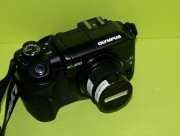Atelier Bonryu(E)
double slit photography


Atelier Bonryu(E)
double slit photography


Double slit photography: When we put together two plates closely, each of which has a vertical slit and a horizontal slit, respectively, the two plates become one plate with a small rectangular hole with a edge length equal to the width of the original slit. Though usually the shape of a pinhole used for the pinhole photography is circular, a rectangular hole causes no problem for photographing. As described in the Aristotle’s problem an image projected by a pinhole is always a similar shape to a photogenic object irrespective of a shape of the pinhole. As a matte of course, therefore, the “pinhole” camera with this rectangular hole can be used to take a photograph. Next, we separate the two plates gradually. Then the pinhole plate with a rectangular hole reverts to the previous two plates with a vertical slit and a horizontal slit, respectively, and an optical system consists of a plate with a vertical slit and a plate with a horizontal slit is obtained. We call this optical system as a double slit(*). As imagined easily a photograph taken by a double slit with a small isolation is very similar to a photograph taken by the “rectangular” pinhole camera. In other words, the pinhole photography is, in a certain sense, a limiting case of the double slit photography.
Laboratory: Double Slit Photography
Theory of Double Slit Photography

A SLR, Olympus E-300, to which a double slit is loaded
Double slit
*Double slit
In the field of quantum mechanics, “double slit” means one plate with two slits, which is also used for demonstration of the feature of a particle as a wave by using the interference phenomenon. We have also used this kind of a plate with two slits for explanation of the interference phenomenon appearing in the theory of a zone plate. Therefore, the definition of the double slit given here may be exceptional. Renner uses in his book generically a word, “slit imaging” which means both single slit and multi-slit photography. There is, however, a completely different “slit camera” in which a slit is set closely to a film and a photograph is taken by feeding a film rapidly. As in a photograph taken by the slit camera the direction of the film movement is regarded as a temporal axis of the motion of the object this kind of camera was conveniently used for judgement of the order of arrival in the races. Moreover, by adjusting the speed of a film appropriately one can take a photograph of a very long train without a perspective distortion. Correspondingly a panorama camera based on the principle of the slit camera can take a panoramic photograph without a distortion in the angular direction. A slit camera for high speed photography is a streak camera which was extensively used in the scientific and engineering fields. There are attempts to use a slit camera for creating artistic photographs (Michio Ohzeki, Aesthetics of After Image<残像の美学>, 1998, in Japanese).




